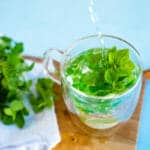Sage Tea
Try this sage tea recipe for a soothing herbal drink made with fresh sage and hot water. It’s simple to make, flavorful, and full of potential health benefits.

When I first started growing herbs, I used them mostly for cooking. But with an abundance of sage taking over my herb garden, I found a new way to use it: herbal tea!
What I love about this sage tea recipe is its simplicity and flavor. You need just fresh sage leaves and hot water, plus honey and lemon to round it out. The result is a caffeine-free hot drink with a pine-forward flavor. It’s great for if you’re dealing with a sore throat, looking for a Mediterranean-inspired herbal tea, or simply want something warm and soothing!
Why You’ll Love This Recipe
It takes 5 minutes. The prep time is essentially zero: just wash your herbs and boil water.
Fresh sage leaves create incredible flavor. The essential oils in the leaves give you an herbal character you can’t get from tea bags.
It’s caffeine-free. Unlike black tea or green tea, sage tea contains no caffeine. This makes it perfect for evening sipping.
There are potential health benefits. Sage has been used in Mediterranean cultures for years as a medicinal herb for helping digestion and sore throats.
It’s great for cold weather and wellness moments. This is my go-to hot drink when I’m under the weather or need a moment of calm.
Health Benefits of Sage Tea
While I primarily make sage tea because I enjoy the flavor, many people drink it for its potential health benefits. I’m not a medical professional, so I can’t make health claims about sage tea. But I can say from personal experience that a warm cup feels incredibly restorative! According to the professionals, fresh sage may have these health benefits:
- Anti-inflammatory properties: Herbalists have used sage for centuries to reduce inflammation
- Soothing for sore throats: The natural compounds may help ease throat pain
- Memory and brain health: Some studies suggest sage may support cognitive function
- Skin health: Sage contains antioxidants that may benefit your skin
- Digestive support: Some people find sage tea soothing for the digestive system

How to Make Sage Tea
Making sage tea couldn’t be simpler, but a few techniques will ensure you get the best flavor every time:
1. Start with quality water.
Fill a kettle with filtered water and bring it to a full boil. I use an electric kettle that we also use for our morning pour over coffee, but any method works fine.
Pro tip: Water quality matters more than you might think! Chlorinated tap water can interfere with the delicate flavor of herbal teas.
2. Prepare your fresh sage.
While the water heats, wash your sage leaves thoroughly to remove any sand or soil under cool running water.
My technique: I leave the leaves attached to the stem rather than chopping them. This makes them much easier to remove after steeping.
3. Steep properly.
Place the sage (about 6 leaves) in a mug and pour over the boiling water. Allow the herbs to steep for 5 minutes—no longer, or the tea may develop bitter notes.
Alternative method: If you prefer, you can also chop the sage leaves and place them in a tea strainer before steeping.
Safety Notes
Before you start brewing cups of sage tea daily, there are a few safety considerations to keep in mind:
- If you’re pregnant or breastfeeding, it’s best to consult your healthcare provider before drinking sage tea.
- Sage could interact with certain medications, including diabetes medications, sedatives, and anticonvulsants. If you’re taking medications, talk to your doctor first.
- An occasional cup of sage tea is fine for most people, but avoid drinking large quantities (more than 3-4 cups daily) because of a compound called thujone. It makes the strong aroma, but it can be toxic in high doses.
Growing Sage at Home
If you’re not already growing sage, let me convince you to start. Sage is one of the easiest, most forgiving herbs you can grow, Here are my tips for growing sage:
- Location: Choose a spot with full sun (at least 6 hours daily): you can grow it in a pot or garden bed
- Soil: Well-draining soil is essential: sage doesn’t like wet feet
- Water: Once established, sage is drought-tolerant and needs minimal watering
- Harvesting: Cut stems rather than picking individual leaves, and never harvest more than ⅓ of the plant at once
- Winter care: In colder zones, mulch around the base before winter to protect the roots

More Ways to Use Sage
Once you start growing sage, you might find yourself with too much of this wonderful herb (I’ve actually had that “problem” a lot!). Here are some of my favorite ways to use sage in recipes beyond tea:
- In savory recipes: My Brown Butter Sage Sauce is delicious over pasta or gnocchi. I also love adding whole sage leaves into a Butternut Squash Lasagna with Sage.
- As a garnish: It looks beautiful and adds a pop of color on Tomato Sage Parmesan Cornbread.
- In soups and stews: You can also add fresh sage to hearty soups like my Tomato Sage Chickpea Soup.
Storage Tips
Wrap fresh sage laves loosely in a damp paper towel and place them in a plastic bag or container in the refrigerator. Stored this way, fresh sage will keep for 7-10 days.
If you brew more tea than you can drink, let it cool and store it in the refrigerator for up to 1 day. However, the flavor may become slightly more bitter as it sits.
Frequently Asked Questions
Sage tea is generally safe, but per this article I don’t recommend drinking large amounts every day due to the thujone content in sage. One to two cups daily is typically considered safe for most people.
You should avoid or limit sage tea if you’re pregnant, breastfeeding, have epilepsy, or take medications that may interact with sage (such as diabetes medications or sedatives). Consult your doctor before you add sage tea to your routine.
Easy Sage Tea
Here’s how to make sage tea, a restorative herbal tea made with just boiling water and fresh sage!
- Prep Time: 5 minutes
- Cook Time: 0 minutes
- Total Time: 5 minutes
- Yield: 1 drink
- Category: Drink
- Method: Tea
- Cuisine: Herbal
- Diet: Vegan
Ingredients
- 6 fresh sage leaves, left on stem
- Boiling water
- Honey (or agave syrup for vegan)
- 1 lemon wedge
Instructions
- Bring the water to a boil.
- Wash the sage thoroughly.
- Place the sage in a mug, and pour over the boiling water. Allow the herbs to steep for 5 minutes. (Alternate method: If you prefer, you can also chop the sage leaves and place them in a tea strainer before steeping.)
- Remove the sage. Stir in a drizzle of honey and a squeeze of lemon (required for the best flavor).
Other herbal tea recipes I love
You can make tea with all sorts of herbs! Here are a few more of the herbal tea recipes we’ve made, each with their own distinct flavor:
from A Couple Cooks
https://ift.tt/UBhnvij
Sonja Overhiser
October 08, 2025 at 11:00AM






Comments
Post a Comment